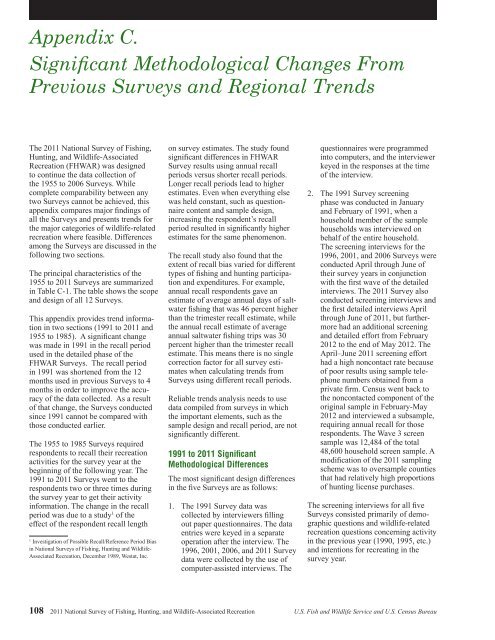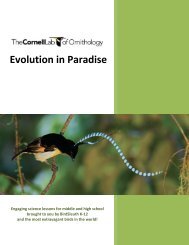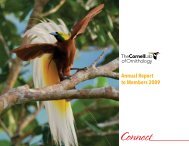National Survey of Fishing, Hunting, and Wildlife ... - All About Birds
National Survey of Fishing, Hunting, and Wildlife ... - All About Birds
National Survey of Fishing, Hunting, and Wildlife ... - All About Birds
You also want an ePaper? Increase the reach of your titles
YUMPU automatically turns print PDFs into web optimized ePapers that Google loves.
Appendix C.Significant Methodological Changes FromPrevious <strong>Survey</strong>s <strong>and</strong> Regional TrendsThe 2011 <strong>National</strong> <strong>Survey</strong> <strong>of</strong> <strong>Fishing</strong>,<strong>Hunting</strong>, <strong>and</strong> <strong>Wildlife</strong>-AssociatedRecreation (FHWAR) was designedto continue the data collection <strong>of</strong>the 1955 to 2006 <strong>Survey</strong>s. Whilecomplete comparability between anytwo <strong>Survey</strong>s cannot be achieved, thisappendix compares major findings <strong>of</strong>all the <strong>Survey</strong>s <strong>and</strong> presents trends forthe major categories <strong>of</strong> wildlife-relatedrecreation where feasible. Differencesamong the <strong>Survey</strong>s are discussed in thefollowing two sections.The principal characteristics <strong>of</strong> the1955 to 2011 <strong>Survey</strong>s are summarizedin Table C-1. The table shows the scope<strong>and</strong> design <strong>of</strong> all 12 <strong>Survey</strong>s.This appendix provides trend informationin two sections (1991 to 2011 <strong>and</strong>1955 to 1985). A significant changewas made in 1991 in the recall periodused in the detailed phase <strong>of</strong> theFHWAR <strong>Survey</strong>s. The recall periodin 1991 was shortened from the 12months used in previous <strong>Survey</strong>s to 4months in order to improve the accuracy<strong>of</strong> the data collected. As a result<strong>of</strong> that change, the <strong>Survey</strong>s conductedsince 1991 cannot be compared withthose conducted earlier.The 1955 to 1985 <strong>Survey</strong>s requiredrespondents to recall their recreationactivities for the survey year at thebeginning <strong>of</strong> the following year. The1991 to 2011 <strong>Survey</strong>s went to therespondents two or three times duringthe survey year to get their activityinformation. The change in the recallperiod was due to a study 1 <strong>of</strong> theeffect <strong>of</strong> the respondent recall length1Investigation <strong>of</strong> Possible Recall/Reference Period Biasin <strong>National</strong> <strong>Survey</strong>s <strong>of</strong> <strong>Fishing</strong>, <strong>Hunting</strong> <strong>and</strong> <strong>Wildlife</strong>-Associated Recreation, December 1989, Westat, Inc.on survey estimates. The study foundsignificant differences in FHWAR<strong>Survey</strong> results using annual recallperiods versus shorter recall periods.Longer recall periods lead to higherestimates. Even when everything elsewas held constant, such as questionnairecontent <strong>and</strong> sample design,increasing the respondent’s recallperiod resulted in significantly higherestimates for the same phenomenon.The recall study also found that theextent <strong>of</strong> recall bias varied for differenttypes <strong>of</strong> fishing <strong>and</strong> hunting participation<strong>and</strong> expenditures. For example,annual recall respondents gave anestimate <strong>of</strong> average annual days <strong>of</strong> saltwaterfishing that was 46 percent higherthan the trimester recall estimate, whilethe annual recall estimate <strong>of</strong> averageannual saltwater fishing trips was 30percent higher than the trimester recallestimate. This means there is no singlecorrection factor for all survey estimateswhen calculating trends from<strong>Survey</strong>s using different recall periods.Reliable trends analysis needs to usedata compiled from surveys in whichthe important elements, such as thesample design <strong>and</strong> recall period, are notsignificantly different.1991 to 2011 SignificantMethodological DifferencesThe most significant design differencesin the five <strong>Survey</strong>s are as follows:1. The 1991 <strong>Survey</strong> data wascollected by interviewers fillingout paper questionnaires. The dataentries were keyed in a separateoperation after the interview. The1996, 2001, 2006, <strong>and</strong> 2011 <strong>Survey</strong>data were collected by the use <strong>of</strong>computer-assisted interviews. Thequestionnaires were programmedinto computers, <strong>and</strong> the interviewerkeyed in the responses at the time<strong>of</strong> the interview.2. The 1991 <strong>Survey</strong> screeningphase was conducted in January<strong>and</strong> February <strong>of</strong> 1991, when ahousehold member <strong>of</strong> the samplehouseholds was interviewed onbehalf <strong>of</strong> the entire household.The screening interviews for the1996, 2001, <strong>and</strong> 2006 <strong>Survey</strong>s wereconducted April through June <strong>of</strong>their survey years in conjunctionwith the first wave <strong>of</strong> the detailedinterviews. The 2011 <strong>Survey</strong> alsoconducted screening interviews <strong>and</strong>the first detailed interviews Aprilthrough June <strong>of</strong> 2011, but furthermorehad an additional screening<strong>and</strong> detailed effort from February2012 to the end <strong>of</strong> May 2012. TheApril–June 2011 screening efforthad a high noncontact rate because<strong>of</strong> poor results using sample telephonenumbers obtained from aprivate firm. Census went back tothe noncontacted component <strong>of</strong> theoriginal sample in February-May2012 <strong>and</strong> interviewed a subsample,requiring annual recall for thoserespondents. The Wave 3 screensample was 12,484 <strong>of</strong> the total48,600 household screen sample. Amodification <strong>of</strong> the 2011 samplingscheme was to oversample countiesthat had relatively high proportions<strong>of</strong> hunting license purchases.The screening interviews for all five<strong>Survey</strong>s consisted primarily <strong>of</strong> demographicquestions <strong>and</strong> wildlife-relatedrecreation questions concerning activityin the previous year (1990, 1995, etc.)<strong>and</strong> intentions for recreating in thesurvey year.108 2011 <strong>National</strong> <strong>Survey</strong> <strong>of</strong> <strong>Fishing</strong>, <strong>Hunting</strong>, <strong>and</strong> <strong>Wildlife</strong>-Associated Recreation U.S. Fish <strong>and</strong> <strong>Wildlife</strong> Service <strong>and</strong> U.S. Census Bureau






